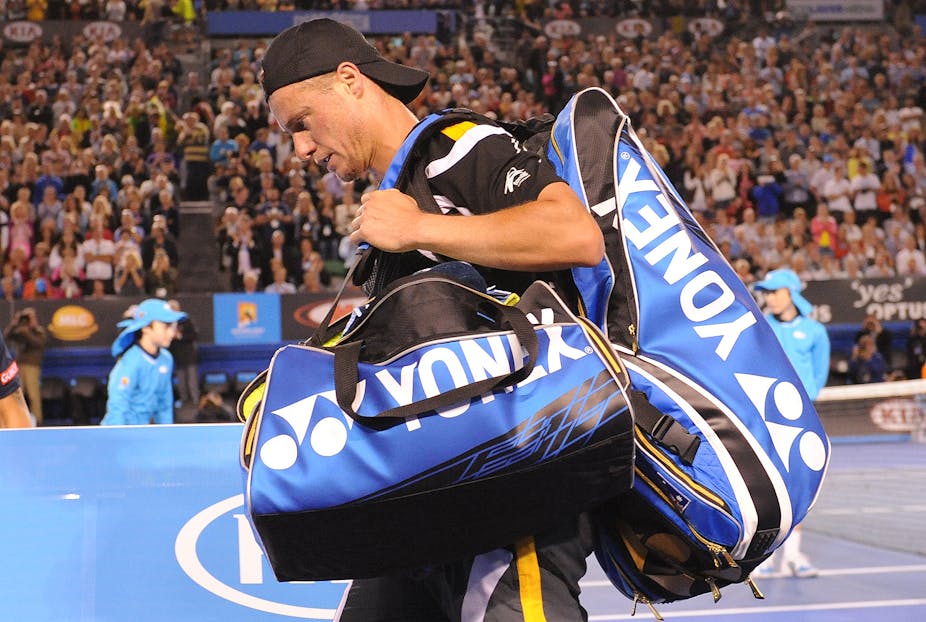Any hopes that Lleyton Hewitt could revisit past glories in his 2013 Australian Open campaign were dashed last night when he lost in straight sets to Serbia’s Janko Tipsarevic. It now seems impossible to deny, as Greg Baum wrote for The Age, that “the post-Hewitt era looms ever nearer”.
The recent retirement of former Australian cricket captain Ricky Ponting sparked similar debate about athletes playing on past their prime. While there is no doubt as to the significant contribution and influence Ponting had on the game of cricket, many have questioned whether his retirement from the sport should have occurred some time before he was plagued by run of poor batting scores.
And in Australian Rules football, the oldest player in the league, Essendon’s Dustin Fletcher, will “go round” for another year during the 2013 season.
Why is it that athletes seem unable or unwilling to withdraw from sport before their best days are long behind them? Retirement from sport is inevitable; so why do athletes choose not to bow out gracefully before the general public starts demanding they go? After all, athletes who can retire on their own terms are much more likely to transition well out of the sport than those who are forced into retirement through injury or by being cut from their team.
Sport has long been regarded as a place where young boys learn the traditional values associated with being a man, such as competition, toughness and winning at all costs. One of the ways men can demonstrate their masculine identity is through “doing” masculinity (as opposed to being masculine), and sport is one of the most common ways. The male body, therefore, becomes a central aspect of masculine identity.
Towards the end of careers when athletes’ bodies are succumbing to the brutal nature of elite sport, the realisation that one’s body cannot do what it used to be able to do can lead to masculine identity becoming vulnerable.
For many men, it is extremely difficult to acknowledge that their bodies are failing them. Continuing to play on beyond one’s physical prime may therefore be due to an unwillingness to recognise the physical limitations of a failing body.
How well an athlete retires from sport depends on how much of their identity is wrapped up in being a sportsman. For those whose whole identity is solely comprised of being an athlete, leaving the sport is much more difficult: if they are not an athlete then who are they?
But people do not stop being sportsmen simply because they have retired from sport, neither do they stop being men. So the problem lies not in what they are able to do to but what they want to do, as nothing compares to life as an athlete.

Existence as an elite athlete is often described as being the “perfect life”. Not only are our male sporting superstars paid extremely well for doing what they love, they are given hero status in society. Particularly in Australia, where sport has such significance, the recognition, stardom and rewards that are associated with being an elite sportsman are difficult to give up.
When an athlete does retire, whether forced to or by choice, a period of readjustment occurs. Even those who spend the later part of their careers preparing for life after sport still experience difficulties leaving their former life behind. This can in part due to athletes still being comparatively young when they retire. Even Ricky Ponting at 37 still has another 30 years in which to build an alternative career.
It is through this subsequent career that masculine identity is then reconstructed. Success in post-sporting career employment is one of the fundamental ways in which masculinity is reaffirmed, suggesting that the importance of a new career path is crucial to successfully withdrawing from elite sport.
Given the sole focus on sport as a career path from a young age, alternative careers are often overlooked. With such a small percentage of aspiring young athletes making it to the elite level, is it any wonder those who do want to hang onto it for as long as possible?
Athletes know when their performance starts to decline so the end of their career is not necessarily a surprise, but playing beyond their prime does delay the consequences of having to cope with life after sport. Many still feel they have much to contribute.
Perhaps this is why so many former athletes seek careers in commentary; it is a means by which they can still contribute to and hold onto the sport that has been a significant and enjoyable part of their lives.
It should be noted that retiring female athletes no doubt also have difficulty adjusting to life without sport. But sport shapes masculine identity in such a distinct manner that male athletes have been the focus of this discussion.
Retirement from sport does not have to be all doom and gloom. The new era offers new challenges and alternative pathways to success, through which masculine identity can be reaffirmed.
The question then is not whether there is life after sport, but rather when is the right time to let go?

